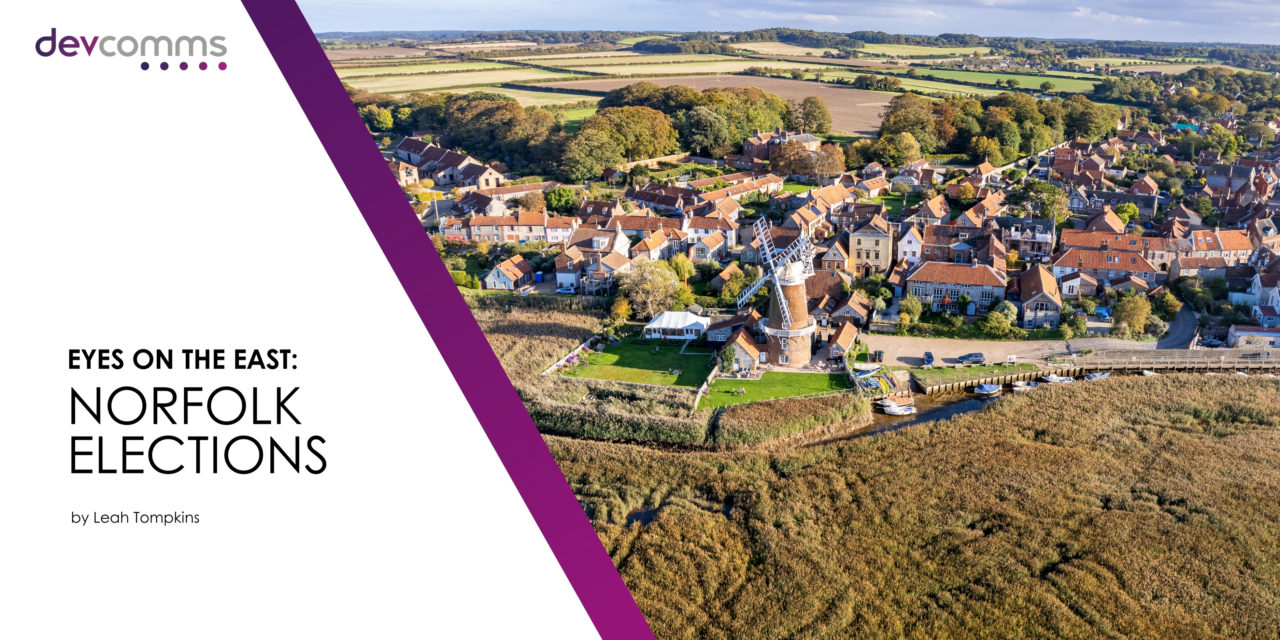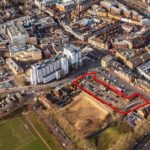In the third report in a series by DevComms, ploughing a route through the East of England’s political minefields, senior account manager Leah Tompkins explores the complex politics at play at Norwich City Council and the Norfolk South West constituency where a former Prime Minister could be fighting for political survival.
As the political landscape in Norfolk evolves, all eyes turn to the upcoming local elections at Norwich City Council and the forecasted prediction for Norfolk South West constituency in the ever looming General Election.
In the heart of this picturesque county, political fervour grips constituents, echoing the diverse voices and concerns of the region. From housing policies to environmental initiatives, the electorate’s decisions hold significant weight in shaping the future shape of local governance.
With anticipation mounting, join me as I delve into the intricacies of Norwich City Council’s party dynamics and Norfolk South West’s candidate platforms, as I attempt to unravel the impending electoral outcomes.
Norwich City Council
Political tension is palpable at Norwich City Council as Norwich locals prepare to cast their votes amid a landscape fraught with party dynamics and local controversies at the local elections, scheduled to take place on May 2, 2024.
With 13 of the total 39 seats up for contention this year, the stakes are high as one seat in each three-member ward is set to undergo the electoral crucible. The political map of City Hall reflects a delicate balance, with Labour holding 19 seats, closely followed by the Green Party with 13, while four independents and three Liberal Democrats complete the political composition of the council. However, Labour’s dominance faces a significant challenge following a spate of resignations in November 2023 which came as a result of local internal party politics. The resignations eroded the party’s overall majority, leaving Norwich City Council under no overall control.
Among the notable contenders at this year’s local election is Ian Stutely, a former Labour member turned independent, whose bid for Town Close as an independent seat symbolises the broader struggle within local politics following the Labour Party opting to stop Cllr Stutely from standing in this year’s election for the party. The Greens, buoyed by recent victories, eye further gains, especially in Wensum ward, aiming to capitalise on their momentum and expand their influence.
As Norwich braces for a pivotal electoral showdown, the outcome remains uncertain, embodying the convoluted interplay of party politics and grassroots aspirations shaping the city’s future.
Norfolk South West constituency
Despite a Tory slump predicted in the national polling, Liz Truss stands resolute in her determination to retain her position as the Member of Parliament for South West Norfolk.
As the looming General Election approaches, recent polls, namely Electoral Calculus and Best for Britain, suggest a precarious hold for the Conservatives in Norfolk. While Truss acknowledges the forthcoming electoral contest as ‘tough’, she underscores her commitment to continue serving her constituents diligently.
However, the reliability of such polls has recently been questioned in an article published by East Anglia Bylines, particularly regarding their capacity to account for local dynamics, including party strength, historical voting patterns, and candidate recognition. Liz Truss’s notorious recent stint as Prime Minister has certainly increased her profile nationally and we are therefore yet to see whether this will be of benefit to the Conservatives in the South West Norfolk constituency.
The emergence of independent candidates, such as former Norfolk High Sheriff James Bagge and Labour’s Terry Jermy, signals a shifting landscape in South West Norfolk’s political arena. Bagge’s decision to contest the election as an independent, partly fuelled by his past opposition to Truss, and Jermy’s candidacy, bolstered by his longstanding community engagement and local leadership roles, inject fresh vigour into the electoral discourse.
Moreover, Truss’s brief and tumultuous tenure as Prime Minister casts a shadow over her incumbency, with voters potentially re-evaluating their allegiances. As the seat inches closer to a battleground, characterised by evolving political allegiances and strategic manoeuvring, the outcome of the forthcoming election remains uncertain, with Truss facing a tighter race than in previous years.
The electorate’s verdict will not only determine the fate of South West Norfolk but also serve as an indicator for broader shifts in British politics, underlining the nuanced interplay between national dynamics and local considerations in electoral decision-making.
To conclude, as the countdown to the local elections ticks away, Norwich city finds itself at a crossroads of political intrigue. With Norwich City Council delicately balanced and the spectre of Labour’s eroding dominance, every seat up for election is a battleground, and every vote counts.
The emergence of independent voices like Cllr Ian Stutely and the Green Party’s momentum add layers of complexity to an already charged atmosphere. Meanwhile, in South West Norfolk, Liz Truss faces a formidable challenge amidst shifting allegiances and the aftermath of her brief stint as Prime Minister. As the electorate prepares to cast their ballots, the outcome remains shrouded in uncertainty, reflecting the intricacies between local aspirations and national currents shaping the political landscape.
Follow these links to the previous articles in this series:
Eyes on the East: crossing borders, shaping futures – the political landscape of Suffolk
and
Eyes on the East: Ely and East Cambridgeshire – a Lib Dem win?
© Eastern Echo (powered by ukpropertyforums.com).
Sign up to receive our weekly free journal, The Forum here.


























































